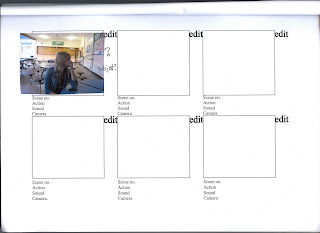We got told today to create a storyboard however in a different form I was familiar with, not to say I don't like the idea. We were to draw our still shots onto post it notes - ones which follow our decided plot - which we would then scan in and produce a video of them.
It allowed us to think of a variety of shots and angels, we tried to be very specific and went into dept, which in turn prepared us extremely well for the actual filming.
So as a group we came together to discuss all our ideas, which in all honesty were all over the place and a mess to start of with, however we were satisfied with our final decisions which will believe will produce a successful OTS.
Shot of femme fatale - crying, distressed, hands on face, from a highish angle at an almost side profile angle - as if from the corner of a room but as high of an angle - TITLE OVER TOP.
Femme fatale looks up - past camera, eyes still.
Close up of woman's face.
Flashback to her in bar/café with two friends - table in view, drink and the shoulders of her two friends either side. Facial expression - none, looking into nothing - 'sense of being trapped' - camera zooms out; see one of her friends putting on her make up - one talking to our femme fatale. Shot stays for a few seconds.
Shot of friends exiting café, kissing goodbye
Close up shot of our femme fatale saying good bye to her last friend - kissing her on cheek - she catches a glimpse of something.
Eye line match - our anti hero, standing up against wall, smoking - possibly a tilt, from foot to head.
Possible close up of different features on our anti-hero - clothing, oil stains on vests.
Close up of mouth smoking and blowing smoke.
Close up of eyes
Shot of friend leaving our femme fatale - in view; her chest upwards, on one side of frame, her friend walking off in distance on other.
Long shot of her standing on cobbled street - she catches herself, establishing her femme fatale character once more.
Moving object shot - femme fatale walking into the shot past our anti-hero still up against wall.
Shot from anti-heroes eyes, watching our femme fatale walk past.
Shot of femme fatale from in front, seeing her intentionally ignore anti-hero and rummage in her bag, walking quickly.
Shot of lighter falling.
Close up as lighter hits floor - slow motion.
Long shot, as if from the café entrance, looking onto where femme fatale has just walked - anti hero in view, picking up what femme fatale has dropped and in distance, femme fatale walking away still rummaging in bag.
Shot of femme fatale rummaging in bag, gets out cigarette holder and looks for lighter.
Shot of anti-hero; bent on floor.
Shot from other side of anti-hero standing up [camera moves up as he does] and lights cigarette with lighter - taking another toke on his cigarette - puts lighter in pocket - beginning to walk quickly away from camera and towards femme fatale.
Shot from front of him walking towards us with femme fatale in view - ''this yours miss?'' - see femme fatale half turn.
Shot from side profile [long shot] - seeing his hand outstretched handing her lighter - she takes the lighter, lights her cigarette looks down at his feet.
Tilt shot, showing femme fatale giving him the 'once over' - ends with shot of anti heroes face where he says: ''where you off to?''
close up of femme fatales face - ''is it any of your business?''
Shot of anti heroes face - ''no but you can't blame a fella for being interested can you,'' - his eyes look over her.
Close up of femme fatales face - ''What's your name?''
Close up of anti heroes face - ''Your interested [grin], ######''
Close up of femme fatales face - ''Oh, no, just being polite.''
Close up of anti heroes face, - ''What's your name? See you're not the only one with manners''
Close up of femme fatales face - ''No? Well I've got things to do, I might see you around.''
Long shot of femme fatale walking away from anti-hero.
Close up of anti hero - takes a toke on his cigarette and looks away to the side of him - an intended way of making him look as though he's not interested but seeing if anyone's seen what's just happened.
Close up of femme fatales face walking away - a toke on her cigarette and a smile.
The dialogue we have chosen will be performed by our actors in a number of different senses and tones;
flirtatious
uninterested
awkward
nervous
who knows.. we'll experiment to see what is most suitable.
Of course things could easily change, maybe we get to our location and realize that particular angel and framing may possibly not work, however it's nice to have some freedom. We aren't the type of group who will be able to stick exactly to our plan - we're always coming up with new, inventive ideas.
As I say, further into development we may choose to alter certain ideas, however I will cover all of this later in my evaluation.















